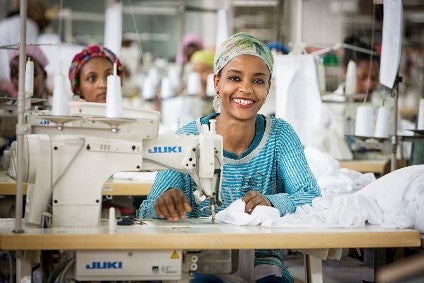
Ethiopia’s clothing and textile sector needs to invest in creating a reliable quality domestic supply chain to grow and meet government targets for expanding export sales.
Sintayehu Teshome, a textile and garment engineer working at the Ethiopian Textile and Garment Association (ETGAMA), which represents more than 120 medium and large companies, believes the sector still has many challenges to overcome to fulfil its potential.
This is despite government incentives such as the construction of industrial parks and generous investment lease policies, as well as Ethiopia’s low labour costs.
Ethiopia’s clothing exports should be booming, he says. The government is keen to leverage the fact that 47% of the 105 million population of Ethiopia should be “considered as working youth.”
It has been building and commissioning nine industrial parks, offering 99 years leases for investors, seven-years-long excise tax breaks for imported raw materials and equipment, and favourable access to foreign markets such as the US through initiatives such as the African Growth and Opportunity Act (AGOA).
But that is not the case. Figures from the state Ethiopia Textile Industry Development Institute (TIDI) show Ethiopia missing government targets.

US Tariffs are shifting - will you react or anticipate?
Don’t let policy changes catch you off guard. Stay proactive with real-time data and expert analysis.
By GlobalDataExport goals
For instance, the aim was for the country’s textile and clothing sector to earn US$160m in export revenue during the first eight months of the current Ethiopian fiscal year 2019/2020, which started on 8 July 2019. But only US$129m was earned – 20% off the government’s goal.
“The sector suffers from lack of coherent value chain, one reason Ethiopia hasn’t been able to use even one percent of opportunities afforded under AGOA,” Sintayehu notes.
He blames textile and garment manufacturers’ failure to meet the quality, price, social, environmental and environmental concerns of buyers. “Our manufacturers think to meet these requirements is too costly.”
Also, transport infrastructure is still too poor, despite the new Addis Ababa-Djibouti railway. “The distance between the production area to Djibouti port is very far and infrastructure is not being upgraded enough.”
Moreover, manufacturers still tend to use “obsolete technologies [that] have resulted in low production and even lower quality affecting our export revenues,” Sintayehu told just-style.
While investors are ready to spend on the sector, they often make poor decisions by lacking “knowledge affecting the growth of the industry,” hindered by weak links between Ethiopian universities and industries, which has prevented well-trained graduates getting the right jobs.
Support
A solution, the official says, is to provide “adequate capacity support…to firms and textile related associations” so they have the ability to attract the right investors and expertise, to expand in the right way to successfully target export markets such as the European Union and the US – bringing more foreign exchange into Ethiopia, and creating a virtuous circle of receipts and investment.
And the base for success is there. While Ethiopia has not been hitting its export targets, sales have been growing thanks to companies based in the industrial parks. In the 2016/2017 fiscal year, Ethiopia earned only US$89.3m from textile and garment exports out of a target of US$271m.
The government has also become more realistic in its planning. Past Prime Minister Hailemariam Desalegn had targeted an additional US$1bn in textile and garment sales every year, to reach US$30bn annually by 2030.
But these plans were scaled down by new Prime Minister Abiy Ahmed who took power during April 2018. He has been more sceptical about the potential boom in growth and the benefits offered by industrial parks to the sector – focusing more on liberalising and privatising state dominated sectors.
Despite this, gains have been made in Ethiopia’s garment export sector. A report last year by the NYU Stern Center for Business and Human Rights found that Western brands and foreign investors in Ethiopia will play a major role in determining whether manufacturing there is profitable for both companies and workers. Executives at the Center shared with just-style their advice on how to support a virtuous sourcing circle in Ethiopia.
An EU-funded project is set to benefit some 17,000 garment workers in Ethiopia by creating a sustainable, transparent and inclusive cotton and garment value chain, from Ethiopian cotton to European consumers.
And the International Labour Organization (ILO) has also launched a programme to promote decent work and inclusive industrialisation in Ethiopia – with an initial focus on the garment and textile industries.



